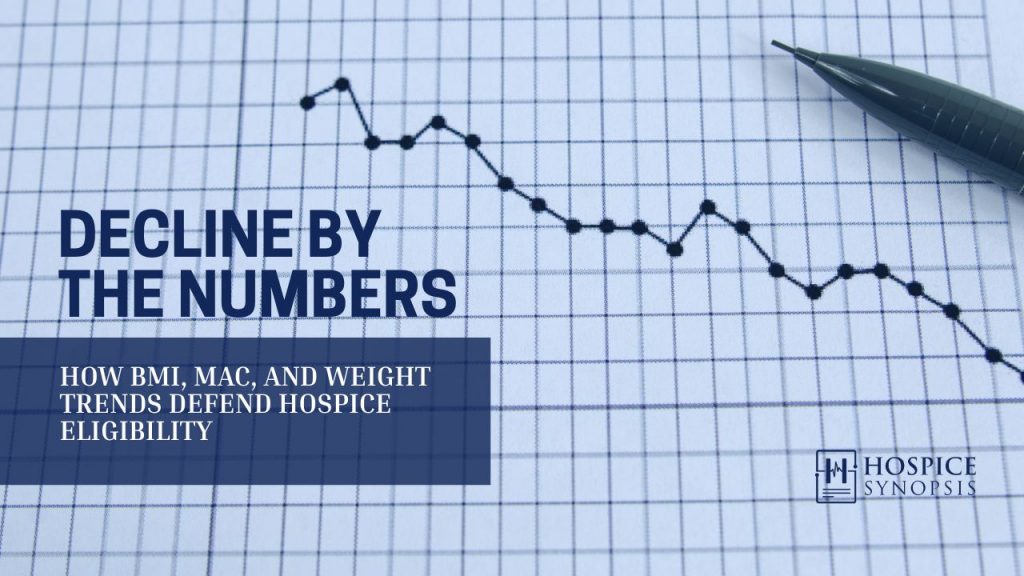
I. Introduction
In prior blogs [Metrics That Matter] we traced hospice metrics from Graunt’s mortality tables to [PPS] and [FAST]. Now we turn to frontline numbers that can make or break eligibility: BMI, MAC, and weight trends.
II. Decline by the Numbers
She hadn’t eaten more than a few bites in days. The scale still read 116 pounds. Her daughter thought that meant stability. Then we measured her mid-arm circumference: 20.6 cm, down 2 cm in four weeks. Beneath the fluid, her body was fading. That number anchored the case and redirected the plan.
Her daughter closed her eyes and whispered, “I knew something was wrong.” Without the MAC, the muscle loss might have stayed hidden.
Auditors demand the story told in numbers. And families feel the same, because metrics anchor the truth. Without them, decline may seem invisible. Metrics are frontline tools. They prove eligibility, track decline, and sharpen decisions. In hospice, they separate a chart that tells the story from a chart that collapses under review.
III. When Numbers Conflict
BMI may look steady. Weight may rise. But if MAC falls, that is signal—not noise. Edema, diuresis, and fluid shifts distort the picture. Our job is not just to record numbers but reconcile them.
One patient’s MAC was listed at 28 cm one month and 23.9 the next. He had not wasted that fast. The first was measured over the maximum R sided bicep; the second, correctly at the midpoint of the L arm as prior. His weight still read 130, but he was cachectic. If the error had stood, his eligibility might have been questioned.
When numbers clash, name the cause. Document the context. Accuracy shields the patient’s true condition. Clarity equips the IDG to act on reality.
“In hospice, MAC is the metric that may save the story from obscurity. The tape tells the truth. Measure well.” — Brian H. Black, D.O.
IV. The Consequence of Missing It
An IDG nurse was distraught when her patient was recommended for discharge. She had seen visible wasting, but the chart said “weight stable” and “no changes.” We reviewed the case, documented decline, and the patient stayed on service.
Metrics protect patients, not payors. Without them, the story is left untold. Families lose trust, and auditors deny care. Both are preventable with accuracy, context, and consistent measurement.
V. The Principle of Clarity
Metrics are clarity at the bedside.
- For families, they explain what the eye cannot see.
- For clinicians, they turn impressions into evidence.
- For auditors, they defend eligibility without apology.
Aides notice sleeves hanging looser. Social workers hear, “She doesn’t dine with us anymore.” Chaplains hear prayers grow shorter. Caregivers see meals pushed away. These are metric moments too. Train every team member to document comparison decline, because what is first seen must be measured.
Metrics feel optional until denial comes. Leaders must treat it as mission work, because what feels optional today decides tomorrow.
VI. Common Barriers at the Bedside
- Families may resist weighing or measuring, fearing it adds burden. Explain that metrics protect eligibility and keep care in place.
- Staff may avoid MAC because they haven’t practiced since school. Train and validate technique in IDG.
- Equipment variation (bed scales, hoyer lifts, home bathroom scales) creates drift. Document source every time.
VII. Toolbox: Audit Anchors and CTI Language
Think of BMI, MAC, and weight as the three anchors of eligibility.
| Metric | Eligibility Trigger | Documentation Tip | Risk Flag |
| BMI <22 | Common LCD threshold | Track percent change and date | None |
| MAC <22 cm | Signals undernutrition | Record side, method, and patient position | >2 cm change between visits without reason |
| Weight trend | >5% in 30 days or >10% in 6 months | Document source (bed, hoyer, scale type) | Discrepant with BMI or MAC |
Metric conflict | ___ | Explain divergence clearly in CTI | >10% mismatch between MAC and BMI |
CTI Language Examples
- Weight + BMI drop: “BMI declined from 21.8 to 18.6 over 90 days, with 12-lb loss and diminished intake. MAC dropped 2.1 cm. No diuretic use.”
- Edematous patient: “MAC fell from 26.4 to 23.9 in 3 months. Weight stable. Edema persists with CHF. Trend reflects depletion.”
- Multimodal loss: “Weight dropped from 142 to 128 lbs over 4 months. BMI 19.4. MAC 21.7 cm. These confirm terminal decline.”
MAC in 3 Steps (Teach at IDG)
- Pick one arm—use the same side every time.
- Seat or lay patient flat, sleeve off.
- Wrap tape at midpoint between shoulder and elbow. Record to 0.1 cm.
VII. Threshold Evidence
Recent OIG audit reports confirm that missing weight or MAC documentation remains a top cause of hospice denials (OIG, 2021). Consistent measurement is not optional—it is compliance protection. Here are some numbers to know:
- BMI <22: Appears in LCDs and audits for cancer, CHF, COPD (ESPEN, 2015; CMS LCDs; NHPCO, 2023).
- MAC <22 cm: Marker of undernutrition, especially with dementia, edema, immobility (WHO, 2012; Kaiser et al., 2020; Powell-Tuck & Hennessy, BMJ, 2003).
- Weight loss >5%/30 days or >10%/6 months: Clinically meaningful (Fearon et al., Lancet Oncology, 2011; NIA audit standards).
- CHF + edema: MAC more reliable than BMI or weight when fluid overload distorts the picture (Anker & Coats, Lancet, 1999).
- CMS/NHPCO compliance: LCDs cite BMI, weight, and nutrition as eligibility anchors. Especially for frailty and organ failure trajectories where fluids shifts may make loss. NHPCO (2024) emphasizes consistent documentation as key.
VIII. Legacy
Metrics are the language of decline, the defense of eligibility, and the bridge between what families feel and what clinicians prove.
If every admission carried BMI, MAC, and weight trends, families would see decline before crisis, teams would align, and auditors would find charts that hold.Numbers do not just save the chart, they save trust. That clarity is care.
Three Takeaways
- MAC, BMI, and weight trends are frontline metrics.
- Method matters. Drift creates denials.
- Document decline. Defend it with the charting.
Two Quotes
- “Metrics don’t protect payors, they protect patients.”
- “You are not just charting numbers. You chart charting defensible decline.”
One Question
When the numbers don’t match, what story do you tell?
Bibliography
- Kaiser, M. J., et al. (2020). Validation of the Mini Nutritional Assessment Short-Form (MNA-SF) for use in older adults. Journal of Nutrition, Health & Aging, 24(6), 601–606.
- National Hospice and Palliative Care Organization (NHPCO). (2023). Facts and Figures: Hospice Care in America. Alexandria, VA.
- NHPCO. (2024). Standards of Practice for Hospice Programs. Alexandria, VA.
- ESPEN. (2015). ESPEN guidelines on nutrition in older adults. Clinical Nutrition, 34(6), 1052–1079.
- World Health Organization. (2012). Guidelines on Nutritional Assessment in Older Adults.
Glossary
- BMI (Body Mass Index): Height–weight calculation. In hospice, <22 signals decline; <18.5 often supports eligibility.
- MAC (Mid-Arm Circumference): Measure of body mass and nutrition. Clinically significant below 22 cm. Requires consistent side, position, and method.
- Weight Trend: Decline over time carries more weight than a single snapshot.
- Measurement Drift: Inconsistent technique that corrupts MAC trends.
- Audit Anchor: A stable, consistent metric (BMI, MAC) that defends eligibility.
- MAC Method Standard: Side, patient position, tape type, and arm choice.
- CTI (Certification of Terminal Illness): Physician document certifying life expectancy of six months or less, built on clear evidence of decline.
Sparks
- “BMI isn’t a diet metric in hospice. It’s a decline metric.”
- “MAC without method is malpractice.”
- “When the scale lies, the tape tells the truth.”
- “You don’t chart weight. You chart decline.”
- “If decline isn’t documented, eligibility crumbles. The metrics tell that story—or no one will.”

Leave a Reply